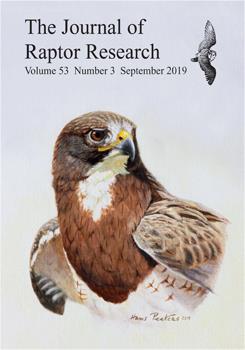Broad-winged Hawks (Buteo platypterus) concentrate in large numbers during migration but several sources suggest regional declines in eastern North America may be occurring, perhaps due to increasing human development, natural resource exploitation, and suburbanization of forests. To better understand the natural history of this secretive nesting species, we used both direct field observations and video cameras to study the nesting ecology of Broad-winged Hawks in three geographic regions of Pennsylvania, each with varying degrees of forest fragmentation. We recorded adult nest attendance, prey deliveries, and nest material deliveries from incubation through fledging. During 891 hr of observation during the nestling period, adult hawks were absent from the nest >72% of the time. Of the time at least one adult was present at the nest during the nestling stage, 77% was spent standing and sheltering, 21% feeding young, and 1% consuming food. Both adults were present at the nest <1% of the time. Mammals, birds, and reptiles and amphibians were the most frequently delivered prey items in that order, with the eastern chipmunk (Tamias striatus) composing >16% of the total prey delivered. Prey deliveries were more frequent during the first 3 wk of the nestling period than during the last 2 wk of the nestling period, but did not vary by time of day. The most frequently delivered nesting material was deciduous sprigs, which made up 55% of deliveries. Nest materials were delivered from incubation until the young were 4 wk old, but delivery rates varied significantly by nesting stage and nestling age. The absence of adults at the nests during nestling and fledgling periods may leave young vulnerable to predators. Although our sample size of nests in fragmented forests was too small for statistical analysis, the relationship between forest fragmentation and Broad-winged Hawk nesting ecology warrants further investigation.
How to translate text using browser tools
13 August 2019
Broad-Winged Hawk Nesting Behavior in Forested Landscapes of Pennsylvania
Rebecca A. Mccabe,
Laurie J. Goodrich,
Terry L. Master,
Zach Bordner
ACCESS THE FULL ARTICLE

Journal of Raptor Research
Vol. 53 • No. 3
September 2019
Vol. 53 • No. 3
September 2019
behavior
breeding
broad-winged hawk
Buteo platypterus
diet
nest material
nesting




